29/05/2016
27/05/2016
RIP Hanako
So sorry. Rest in peace, beautiful one.
Despite years of international outrage at Inokashira Park's treatment of the elephant Hanako and repeated offers to relocate her to an elephant sanctuary, Hanako passed away this week. She died the same way she spent her life ... alone in the zoo's concrete prison where she lived alone for 60 long years. She never felt grass, or dirt or had the comfort of the company of her own kind.
One commenter wrote: "some people who were interviewed a while back said Hanako should stay in the zoo because they liked going to see her...selfish is the kindest word I can use..."
Despite years of international outrage at Inokashira Park's treatment of the elephant Hanako and repeated offers to relocate her to an elephant sanctuary, Hanako passed away this week. She died the same way she spent her life ... alone in the zoo's concrete prison where she lived alone for 60 long years. She never felt grass, or dirt or had the comfort of the company of her own kind.
 |
| Hanako, forgive us. source |
One commenter wrote: "some people who were interviewed a while back said Hanako should stay in the zoo because they liked going to see her...selfish is the kindest word I can use..."
Labels:
critters,
obituaries
26/05/2016
Comment senction 05.26.16
Trump is a
vulgar, self-obsessed billionaire who's new game is to see if he can
buy the Presidency. That's it. He loves the game. He is on no one's
side but his own and will say and do anything to win. Oh he's a charmer
but, once he's got you, he's already moved on. Now he owns the
Republican party. Too bad guys. You lose. Should he win the election, we
all lose. Bush gets credit for stirring up the Taliban and the birth of
ISIS. Trump would top that.
Labels:
comment section
25/05/2016
Elizabeth Warren takes down "small insecure money grubber Donald Trump"
The truth is a beautiful thing. Thank you Elizabeth.
23/05/2016
Pig in a Bentley
We've been in London for about a week now and today we went for a lovely five mile walk beside the Thames. Passing through a segment of a riverside park we met a woman on an outing with a gigantic, black and white, long haired pig and a little white dog. The pig was happily munching what looked like delicious spring grass and the dog was running around investigating everything. I'm not sure if the man leaning on the nearby black Bentley was her husband or her driver but he also smiled when I complimented her on the pig.
Labels:
critters,
DITL,
London,
travel notes,
UK
14/05/2016
Day trip to the past
The way we travel, it's normal for us to walk miles in a day and get back to our apartment late. By that point, I don't have the time, energy or inclination to do a proper post, hence I usually end up writing little or nothing about the wonders we see.
Our recent visit to Ostia Antica, a huge archeological site about 30 kilometers from Rome, was no exception. It was a 12 hour extravaganza of wonders.
Archaeological sites and museums are our downfall. We linger and this is where it gets complicated because, when I linger, there is suddenly so much to see... and so much to learn that I didn't know I want to know.
For example, archaeologists date the beginnings of Ostia Antica in the 4th century BC and mark its high point in the 2nd and 3rd centuries AD. At that time it had around 100,000 inhabitants.
That makes the Ostia Antica of today a 2000 year-old Roman ghost town. How can we rush though a place like that? And, undoubtedly, we're not the only ones who have enjoyed lingering there.
Certainly residents, seafarers, traders and perhaps even a few pirates have lingered and enjoyed convivial conversation in the tavern at the old crossroads across the street from that headless naked guy. And probably many of those people went over to the communal latrine later for another good long chat.
But all things pass and Ostia Antica was finally abandoned in the 9th century though that didn't stop pirates from repeatedly sacking the place during its decline. Even the sea and Tiber river eventually moved away leaving the town landlocked. Then, six hundred years later, Cardinal Giulliano della Rovere, the man who later became Pope Julius II, showed up on the scene.
He was known as the fearsome warrior Pope. Those who crossed him payed the price, sometimes with their life. He is also the Pope who commissioned Michelangelo to paint the Sistine Chapel. But as a Cardinal in 1483, della Rovere began a major renovation of a centuries old Papal castle located just outside Ostia Antica and took many tons of marble from the city for his project. I guess that counts as recycling.
A little went for decoration but most of the marble was crushed, along with the history it represented, plus lime to make mortar to hold the castle's giant stones in place. About a hundred years later, after an extraordinary flood, the Papacy abandoned the place. It was a prison for awhile, sat empty for a couple of centuries and was finally restored in the 19h century to exhibit the first findings from the excavations at Ostia Antica. We noticed it as we were heading back to the train after our very long day but, naturally, went over to have a look.
I didn't start out with the intention of going into all that. This is the problem with visiting a place like Rome and its suburbs, if there even is another place like Rome and its suburbs. Nearly every little thing represents at least a thousand years of history. Fascinating, yes, but a very sticky web to quickly navigate.
Even Ostia Antica, stripped to the bone a thousand years ago, and possibly the most poorly curated major archeological site on the face of the earth, was fascinating. We dragged away.
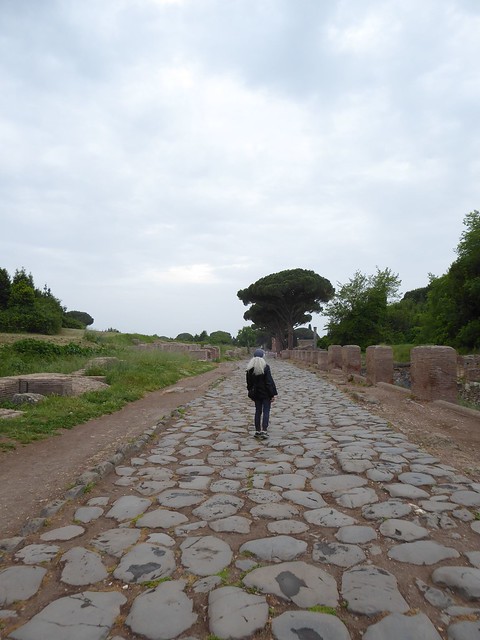 |
| Road to Ostia Antica |
Our recent visit to Ostia Antica, a huge archeological site about 30 kilometers from Rome, was no exception. It was a 12 hour extravaganza of wonders.
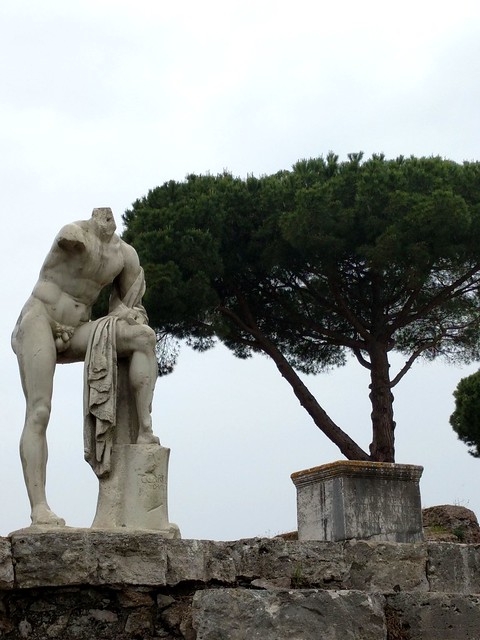 |
| Temple figure at the oldest crossroads in Ostia Antica |
Archaeological sites and museums are our downfall. We linger and this is where it gets complicated because, when I linger, there is suddenly so much to see... and so much to learn that I didn't know I want to know.
 |
| Disturbing Mithraeum of the Baths of Mithras Ostia Antica |
For example, archaeologists date the beginnings of Ostia Antica in the 4th century BC and mark its high point in the 2nd and 3rd centuries AD. At that time it had around 100,000 inhabitants.
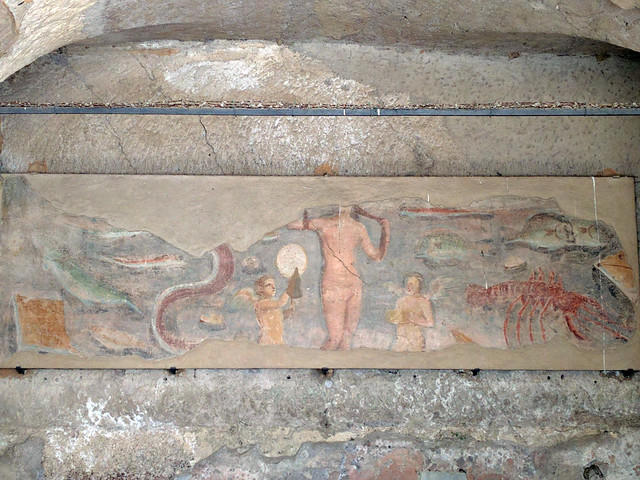 |
| Fresco remains |
That makes the Ostia Antica of today a 2000 year-old Roman ghost town. How can we rush though a place like that? And, undoubtedly, we're not the only ones who have enjoyed lingering there.
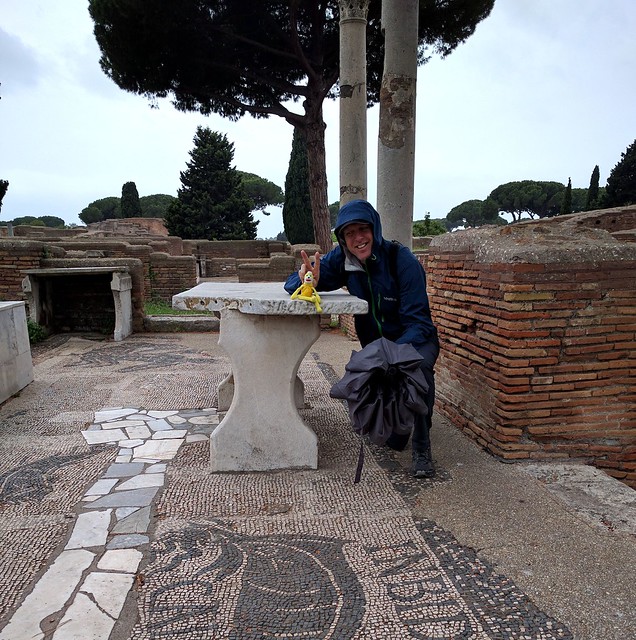 |
| Tavern at the crossroads complete with shady characters. |
Certainly residents, seafarers, traders and perhaps even a few pirates have lingered and enjoyed convivial conversation in the tavern at the old crossroads across the street from that headless naked guy. And probably many of those people went over to the communal latrine later for another good long chat.
 |
| Swami surveying Ostia Antica's 24 seat communal latrine. |
But all things pass and Ostia Antica was finally abandoned in the 9th century though that didn't stop pirates from repeatedly sacking the place during its decline. Even the sea and Tiber river eventually moved away leaving the town landlocked. Then, six hundred years later, Cardinal Giulliano della Rovere, the man who later became Pope Julius II, showed up on the scene.
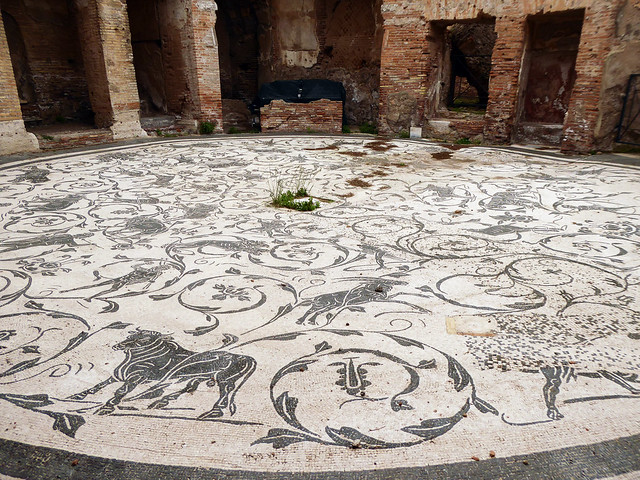 |
| Typical floor in Ostia Antica |
He was known as the fearsome warrior Pope. Those who crossed him payed the price, sometimes with their life. He is also the Pope who commissioned Michelangelo to paint the Sistine Chapel. But as a Cardinal in 1483, della Rovere began a major renovation of a centuries old Papal castle located just outside Ostia Antica and took many tons of marble from the city for his project. I guess that counts as recycling.
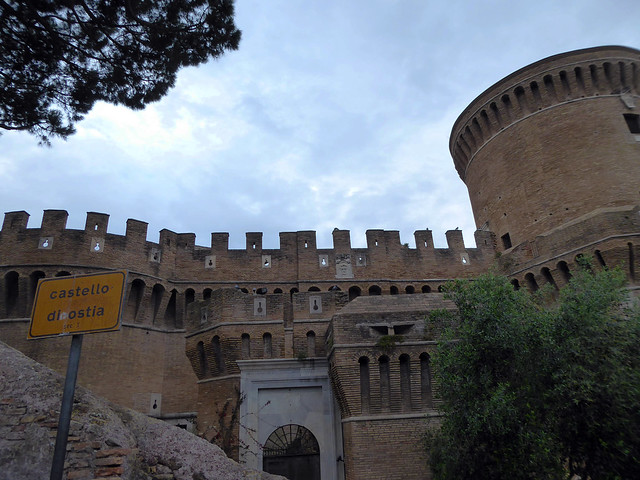 |
| Marble arch to the Castle of Julius II at the end of day. |
A little went for decoration but most of the marble was crushed, along with the history it represented, plus lime to make mortar to hold the castle's giant stones in place. About a hundred years later, after an extraordinary flood, the Papacy abandoned the place. It was a prison for awhile, sat empty for a couple of centuries and was finally restored in the 19h century to exhibit the first findings from the excavations at Ostia Antica. We noticed it as we were heading back to the train after our very long day but, naturally, went over to have a look.
 |
| Cat in his garden by the castle |
I didn't start out with the intention of going into all that. This is the problem with visiting a place like Rome and its suburbs, if there even is another place like Rome and its suburbs. Nearly every little thing represents at least a thousand years of history. Fascinating, yes, but a very sticky web to quickly navigate.
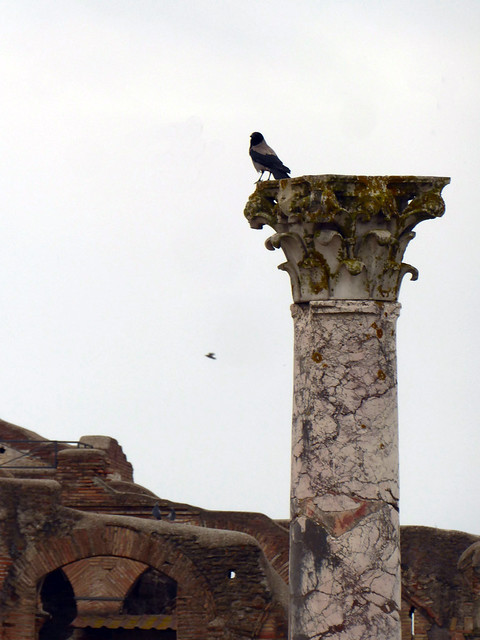 |
| European crow on an ancient marble column |
Even Ostia Antica, stripped to the bone a thousand years ago, and possibly the most poorly curated major archeological site on the face of the earth, was fascinating. We dragged away.
Labels:
EU,
Italy,
travel notes
06/05/2016
First impressions
Rome
Rome is a strange place. For all its wealth, pomp, power and fabulous history, my first impression is that it's a mono culture living off its past. Of course, we've only been here a week and I'm speaking from the impressions I've gathered as we explore the street level of things so I'm probably totally off. In any case, it's an amazing place, an overwhelming place and I'm delighted and grateful to see it.
 |
| Side chapel in a Roman basilica |
Rome is a strange place. For all its wealth, pomp, power and fabulous history, my first impression is that it's a mono culture living off its past. Of course, we've only been here a week and I'm speaking from the impressions I've gathered as we explore the street level of things so I'm probably totally off. In any case, it's an amazing place, an overwhelming place and I'm delighted and grateful to see it.
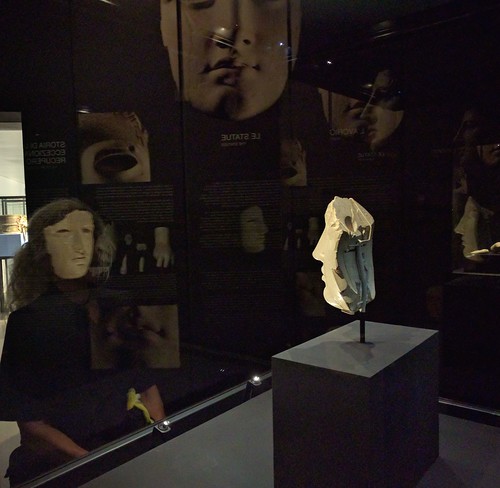 |
| Facing the past Museo Nazionale Romano |
Labels:
EU,
my photos,
Rome,
travel notes
03/05/2016
Make haste slowly
Florence, Italy
Lee describes the historic center of Florence, birthplace of the Renaissance, as a world suspended in amber. It's a perfect description. In 14th century Florence, the merger of Church and secular wealth, power, ruthlessness and creative energy became a flash point transforming western civilization. The Florence of today is the standing record of that fusion suspended in time for all to see.
We stayed in Florence for two weeks, exploring treasures from both the Renaissance and Medieval periods. The city is full of world famous paintings, sculpture and architecture by men such as Brunelleschi, the oldest of the the founding fathers of the Renaissance, Leonardo da Vinci, Raphael, Donatello, Titian, Michelangelo, Botticelli and others. Lisa del Giocondo, the woman Michelangelo painted as the Mona Lisa, lived and is buried in Florence.
Galileo and Michelangelo are also buried there. Dante, however, is not buried there. In 1302 he found himself on the wrong side of a political conflict involving the Pope and in 1315, refusing to pay the fine, was condemned to permanent exile from his beloved Florence or be burned at the stake. In 2008 the city council of Florence passed a motion rescinding his death sentence but thus far the city of Ravenna refuses to give back his bones.
Otherwise, Florence claims many honors. According to wikitravel, Florentines reinvented money, the gold florin which became the engine that drove Europe out of the "Dark Ages". Florentine bankers also financed the first route around Africa to India and the Far East. The Americas were named after a Florentine, Amerigo Vespucci. Florentines also pioneered the use of the vernacular, thus ending the use of Latin as the common language. They invented opera and Ferdinando de' Medici made possible the invention of the piano through his patronage of Bartolomeo Cristofori, a harpsichord builder from Padua.
As for me, the unfinished sculptures Michelangelo were especially powerful, his abandoned figures half-released from the stone. Initially I assumed the unfinished pieces, the rough work, were done by assistants but, when I mentioned this to Lee, he said Michelangelo did most of the work himself, frequently working through the night and, when he did rest, often slept in his boots and clothes. That impressed me and so I read up on him. His biographer Paolo Giovio wrote that "Michelangelo's nature was so rough and uncouth that his domestic habits were incredibly squalid, and deprived posterity of any pupils who might have followed him." Various biographers describe him as solitary and melancholy although he did love one man, Tommaso dei Cavalieri
 |
| Florence, Italy |
Lee describes the historic center of Florence, birthplace of the Renaissance, as a world suspended in amber. It's a perfect description. In 14th century Florence, the merger of Church and secular wealth, power, ruthlessness and creative energy became a flash point transforming western civilization. The Florence of today is the standing record of that fusion suspended in time for all to see.
 |
| Reliquary belonging to House of Medici Florence, Italy |
We stayed in Florence for two weeks, exploring treasures from both the Renaissance and Medieval periods. The city is full of world famous paintings, sculpture and architecture by men such as Brunelleschi, the oldest of the the founding fathers of the Renaissance, Leonardo da Vinci, Raphael, Donatello, Titian, Michelangelo, Botticelli and others. Lisa del Giocondo, the woman Michelangelo painted as the Mona Lisa, lived and is buried in Florence.
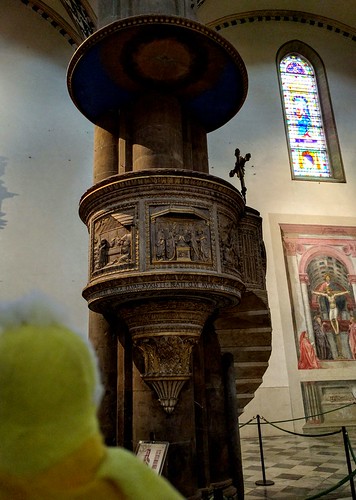 |
| Galileo was first denounced from this pulpit, an event which culminated in him being tried for heresy during the Inquisition. Florence |
Galileo and Michelangelo are also buried there. Dante, however, is not buried there. In 1302 he found himself on the wrong side of a political conflict involving the Pope and in 1315, refusing to pay the fine, was condemned to permanent exile from his beloved Florence or be burned at the stake. In 2008 the city council of Florence passed a motion rescinding his death sentence but thus far the city of Ravenna refuses to give back his bones.
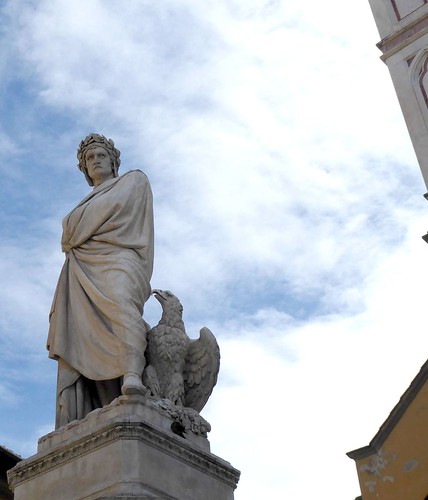 |
| Dante and eagle outside the Duomo Florence |
Otherwise, Florence claims many honors. According to wikitravel, Florentines reinvented money, the gold florin which became the engine that drove Europe out of the "Dark Ages". Florentine bankers also financed the first route around Africa to India and the Far East. The Americas were named after a Florentine, Amerigo Vespucci. Florentines also pioneered the use of the vernacular, thus ending the use of Latin as the common language. They invented opera and Ferdinando de' Medici made possible the invention of the piano through his patronage of Bartolomeo Cristofori, a harpsichord builder from Padua.
 |
| When Michelangelo was an apprentice a rival punched him in the nose "mashing it like a biscuit". It remained that way the rest of his life. Bargello Museum - Florence Italy |
As for me, the unfinished sculptures Michelangelo were especially powerful, his abandoned figures half-released from the stone. Initially I assumed the unfinished pieces, the rough work, were done by assistants but, when I mentioned this to Lee, he said Michelangelo did most of the work himself, frequently working through the night and, when he did rest, often slept in his boots and clothes. That impressed me and so I read up on him. His biographer Paolo Giovio wrote that "Michelangelo's nature was so rough and uncouth that his domestic habits were incredibly squalid, and deprived posterity of any pupils who might have followed him." Various biographers describe him as solitary and melancholy although he did love one man, Tommaso dei Cavalieri
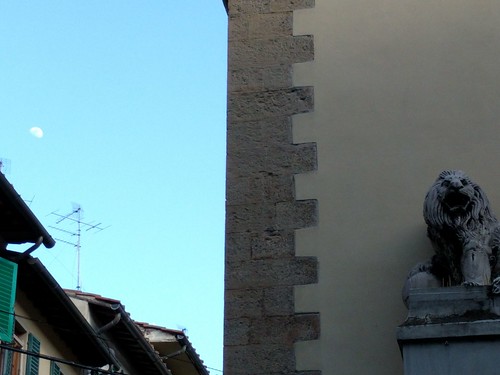 |
| — Festina lente — (make haste slowly) Motto adopted by the House of Medici. Florence morning |
Labels:
art notes,
EU,
Italy,
museum crawl,
The Arts,
travel notes,
UNESCO World Heritage Sites
Subscribe to:
Posts (Atom)
